Development of a Multiple Linear Regression Model for Meteorological Drought Index Estimation Based on Landsat Satellite Imagery
Abstract
1. Introduction
2. Materials and Methods
2.1. Study Area
2.2. MLR
2.2.1. Developing the MLR Model
2.2.2. Model Assessment and Selection
2.3. Data
2.3.1. Drought Indices
2.3.2. Climate Data
2.3.3. Remote Sensing Data
3. Results
3.1. MLR Model Development
3.1.1. Coefficient of Determination
3.1.2. RMSE and MAE
3.1.3. Best Model Selection
4. Discussion
5. Conclusions
Author Contributions
Funding
Conflicts of Interest
References
- Hong, M.; Kim, J.; Jung, G.; Jeong, S. Rainfall Threshold (ID Curve) for Landslide Initiation and Prediction Considering Antecedent Rainfall. Korean Geotech. Soc. 2016, 32, 15–27. [Google Scholar] [CrossRef]
- Mohammad, V. How Do Different Factors Impact Agricultural Water Management? Open Agric. 2016, 1, 89–111. [Google Scholar]
- Mohammad, V. Global Experience on Irrigation Management Under Different Scenarios. J. Water Land Dev. 2017, 32, 95–102. [Google Scholar]
- Weili, D.; Naota, H.; Hideo, S.; Yaning, C.; Shan, Z.; Daniel, N.; Botao, Z.; Yi, W. Evaluation and Future Projection of Chinese Precipitation Extremes Using Large Ensemble High-Resolution Climate Simulations. J. Clim. 2019, 32, 2169–2183. [Google Scholar]
- Shan, Z.; Jilili, A.; Jianli, D.; Weili, D.; Philippe, M.D.; Tim, D.V.V. Description and Attribution Analysis of the 2017 Spring Anomalous High Temperature Causing Floods in Kazakhstan. J. Meteorol. Soc. Jpn. 2020, 2, 70. [Google Scholar] [CrossRef]
- Weili, D.; Bin, H.; Kaoru, T.; Pingping, L.; Maochuan, H.; Nor, E.A.; Daniel, N. Changes of Precipitation Amounts and Extremes Over Japan Between 1901 and 2012 and Their Connection to Climate Indices. Clim. Dyn. 2015, 45, 2273–2292. [Google Scholar]
- Mohammad, V.; Sayed, M.B.; Mohammad, A.G.S.; Mahmoud, R.S.; Vijay, P.S. Complexity of Forces Driving Trend of Reference Evapotranspiration and Signals of Climate Change. Atmosphere 2020, 11, 1081. [Google Scholar]
- Eom, J.; Park, S.; Ko, B.; Lee, C. Monitoring of Lake Area Change and Drought Using Landsat Images and the Artificial Neural Network Method in Lake Soyang, Chuncheon, Korea. J. Korean Earth Sci. Soc. 2020, 41, 129–136. [Google Scholar] [CrossRef]
- Ye, Z.; Yi, L.; Xieyao, M.; Liliang, R.; Vijay, P.S. Drought Analysis in the Yellow River Basin Based on a Short-Scalar Palmer Drought Severity. Water 2018, 10, 1526. [Google Scholar]
- Alex, A.; Rolando, C.; Abel, S.; Javier, P. Probabilistic prediction of drought events using Markov Chain and Bayesian network-based models: A case study of the Andean regulatory river basin. Water 2016, 8, 37. [Google Scholar]
- Ji, L.; Peters, A.J. Assessing Vegetation Response to Drought in the Northern Great Plains Using Vegetation and Drought Indices. Remote Sens. Environ. 2003, 87, 85–98. [Google Scholar] [CrossRef]
- Thomas, B.F.; Famiglietti, J.S.; Landerer, F.W.; Wiese, D.N.; Molotch, N.P.; Argus, D.F. Grace Groundwater Drought Index: Evaluation of California Central Valley Groundwater Drought. Remote Sens. Environ. 2017, 198, 384–392. [Google Scholar] [CrossRef]
- Mu, Q.; Zhao, M.; Kimball, J.S.; McDowell, N.G.; Running, S.W. A Remotely Sensed Global Terrestrial Drought Severity Index. Bull. Am. Meteorol. Soc. 2013, 94, 83–98. [Google Scholar] [CrossRef]
- Een-Sook, K.; Bora, L.; Jong-Hwan, L. Forest Damage Detection Using Daily Normal Vegetation Index Based on Time Series LANDSAT Images. Korean J. Rem. Sens. 2019, 35, 1133–1148. [Google Scholar]
- Jianzhu, L.; Shuhan, Z.; Ro’ng, H. Hydrological Drought Class Transition Using SPI and SRI Time Series by Loglinear Regression. Water Resour. Manag. 2015, 30, 669–684. [Google Scholar]
- Zhang, R.; Chen, Z.Y.; Xu, L.J.; Ou, C.Q. Meteorological Drought Forecasting Based on a Statistical Model With Machine Learning Techniques in Shaanxi Province, China. Sci. Total Env. 2019, 665, 338–346. [Google Scholar] [CrossRef]
- Kang, K.; Jeung, S.J.; Lee, S.; Kim, B. Evaluation of long-term runoff model in unmeasured watershed using satellite data; Focusing on the Imjin River basin. In Proceedings of the 2015 Korea Water Resources Association Annual Conference, Goseong, Korea, 28–29 May 2015. [Google Scholar]
- Peng, F.; Qihao, W. Consistent land surface temperature data generation from irregularly spaced Landsat imagery. Remote Sen. Environ. 2016, 184, 175–187. [Google Scholar] [CrossRef]
- Mun, Y.; Nam, S.W.; Kim, H.; Hong, T.E.; Sur, M.C. Evaluation and comparison of meteorological drought index using multi-satellite based precipitation products in East Asia. J. Kor. Soc. Agric. Eng. 2020, 62, 83–93. [Google Scholar]
- Yun, H.; Um, M.; Cho, W.; Heo, J.H. Orographic Orographic Precipitation Analysis with Regional Frequency Analysis and Multiple Linear Regression. J. Korea Water Resour. Assoc. 2009, 42, 465–480. [Google Scholar] [CrossRef]
- Choi, S.; Han, Y.K.; Kim, Y.B. Comparison of Different Multiple Linear Regression Models for Real-Time Flood Stage Forecasting. J. Korean Soc. Civ. Eng. 2012, 32, 9–20. [Google Scholar]
- McKee, T.B.; Doesken, N.J.; Kleist, J. The Relationship of Drought Frequency and Duration of Time Scales. In Proceedings of the 8th Conference on Applied Climatology, Anaheim, CA, USA, 17–23 January 1993; pp. 179–186. [Google Scholar]
- Sergio, M.V.S.; Santiago, B.; Juan, I.L.M. A Multiscalar Drought Index Sensitive to Global Warming: The Standardized Precipitation Evapotranspiration Index. J. Clim. 2010, 23, 1696–1718. [Google Scholar]
- Palmer, W.C. Meteorological Drought; Department of Commerce Weather Bureau Research: Washington, DC, USA, 1965; Volume 30. [Google Scholar]
- Onyutha, C. On Rigorous Drought Assessment Using Daily Time Scale: Non-Stationary Frequency Analyses, Revisited Concepts, and a New Method to Yield Non-Parametric Indices. Hydrology 2017, 4, 48. [Google Scholar] [CrossRef]
- Tommaso, C.; Simone, V.; Paola, C.; Francesco, F. Drought Analysis in Europe and in the Mediterranean Basin Using the Standardized Precipitation Index. Water 2018, 10, 1043. [Google Scholar]
- Lang, X.; Fen, Z.; Kebiao, M.; Zijin, Y.; Zhiyuan, Z.; Tongren, X. SPI-Based Analyses of Drought Changes over the Past 60 Years in China’s Major Crop-Growing Areas. Remote Sens. 2018, 10, 171. [Google Scholar]
- Rouse, J.W.; Haas, R.H.; Schell, J.A.; Deering, D.W. Monitoring Vegetation Systems in the Great Plains With ERTS. In Proceedings of the 3rd Earth Resource Technology Satellite-1 Symposium, Washington, DC, USA, 10–14 December 1974; Volume 1, pp. 48–62. [Google Scholar]
- Landsat Project Science Office Landsat 8 Science Data User’s Handbook. Available online: http://www.gsfc.nasa.gov/IAS/handbook/handbook_toc.html (accessed on 5 December 2019).
- Kim, G.H.; Hong, S.O.; Kim, D.H.; Park, H.S.; Lee, Y.G.; Kim, B.C. Calculation of Surface Temperature Using Landsat 8 Satellite Data and Analysis of Urban. Greening Effect; Meteorological Application Research Laboratory National Institute of Meteorological Sciences: Jeju, Korea, 2016. [Google Scholar]
- Sekertekin, A.; Bonafoni, S. Land Surface Temperature Retrieval from Landsat 5, 7, and 8 over Rural Areas: Assessment of Different Retrieval Algorithms and Emissivity Models and Toolbox Implementation. Remote Sens. 2020, 12, 294. [Google Scholar] [CrossRef]
- Peterson, K.T.; Sagan, V.S.; Sidike, P.; Cox, A.L.; Martinez, M. Suspended Sediment Concentration Estimation from Landsat Imagery along the Lower Missouri and Middle Mississippi Rivers Using an Extreme Learning Machine. Remote Sens. 2018, 10, 1503. [Google Scholar] [CrossRef]
- Hao, P.; Löw, F.; Biradar, C. Annual Cropland Mapping Using Reference Landsat Time Series—A Case Study in Central Asia. Remote Sens. 2018, 10, 2057. [Google Scholar] [CrossRef]
- Huang, X.; Gao, L.; Crosbie, R.S.; Zhang, N.; Fu, G.; Dobble, R. Groundwater Recharge Prediction Using Linear Regression, Multi-Layer Perception Network, and Deep Learning. Water 2019, 11, 1879. [Google Scholar] [CrossRef]
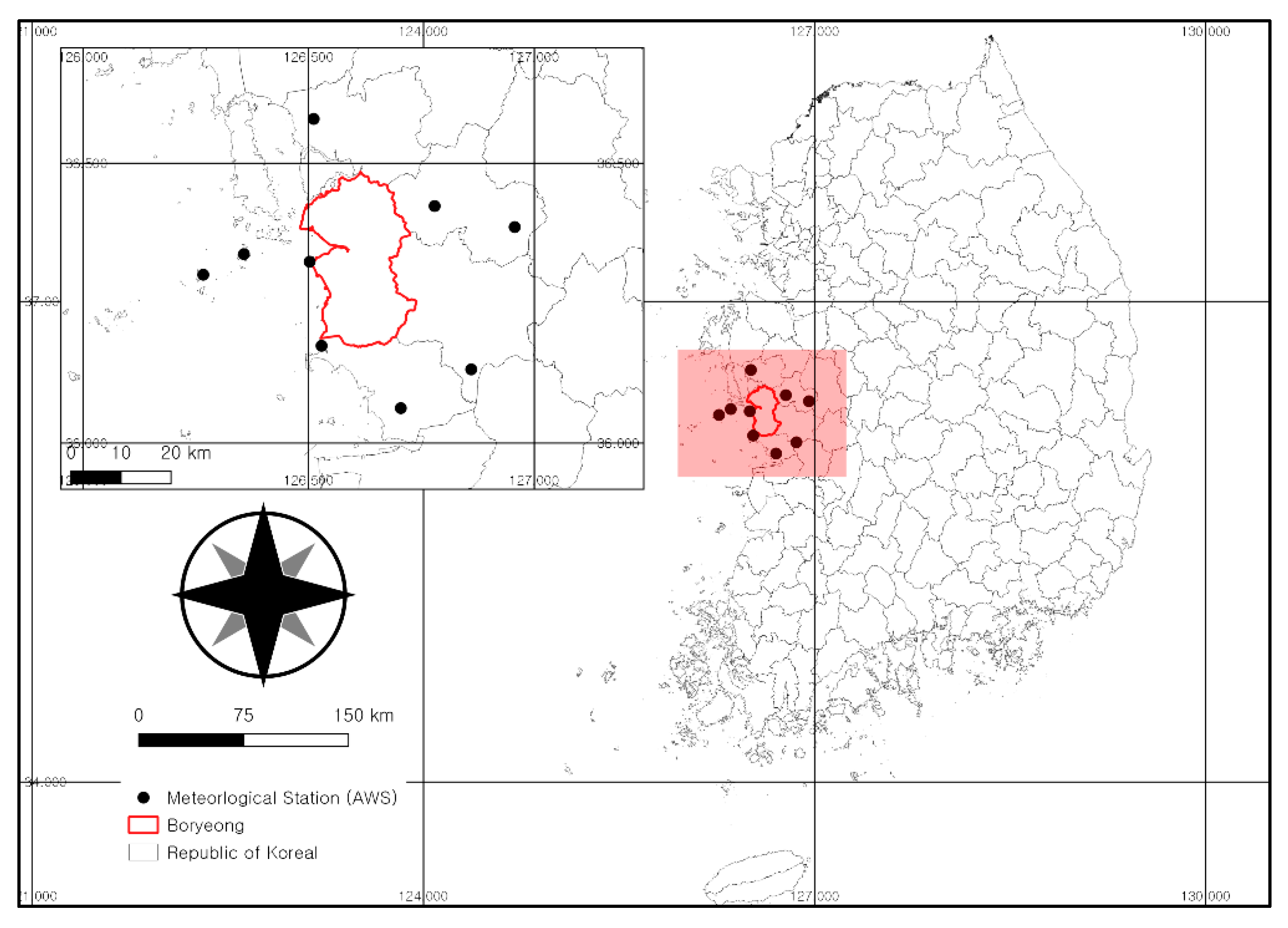
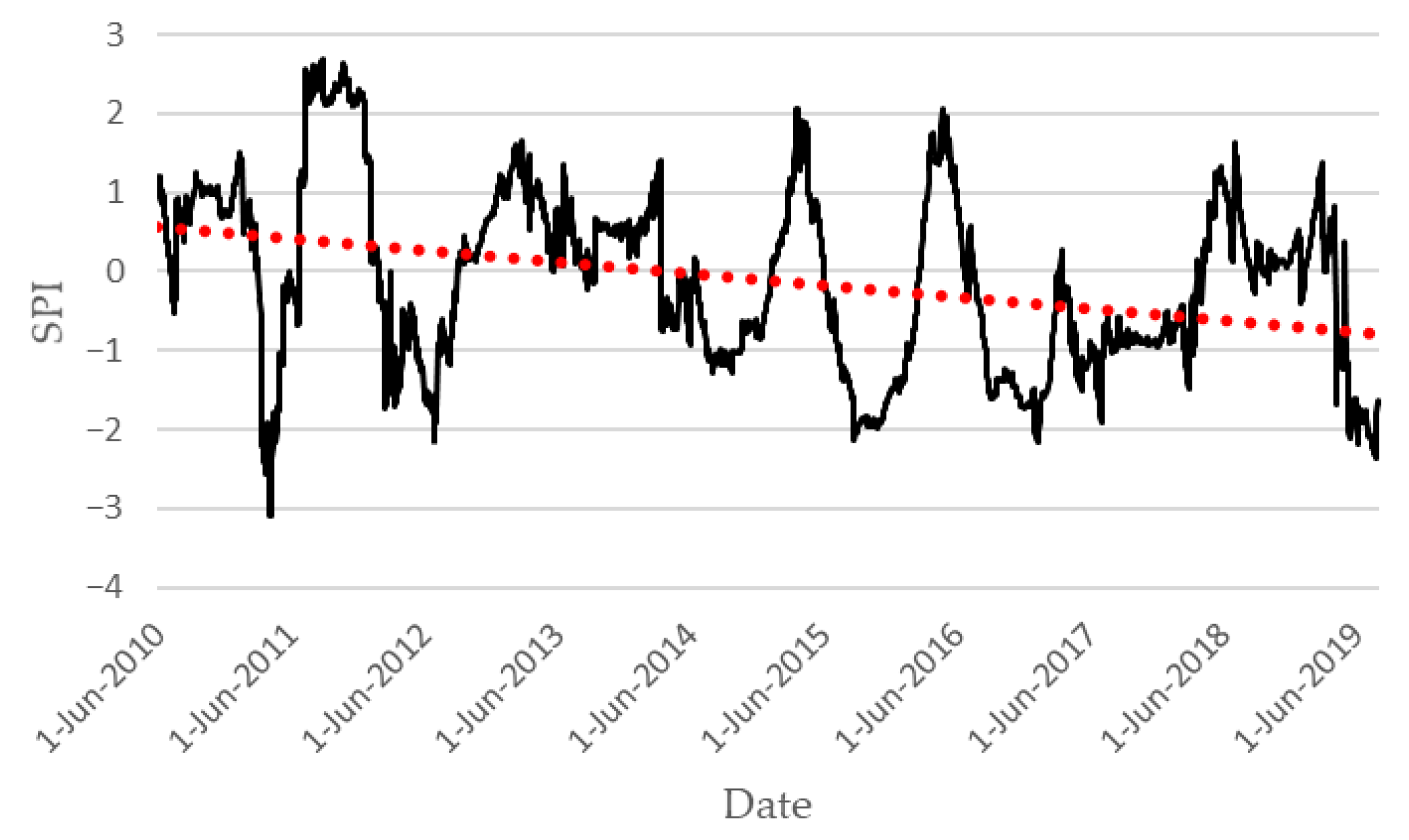
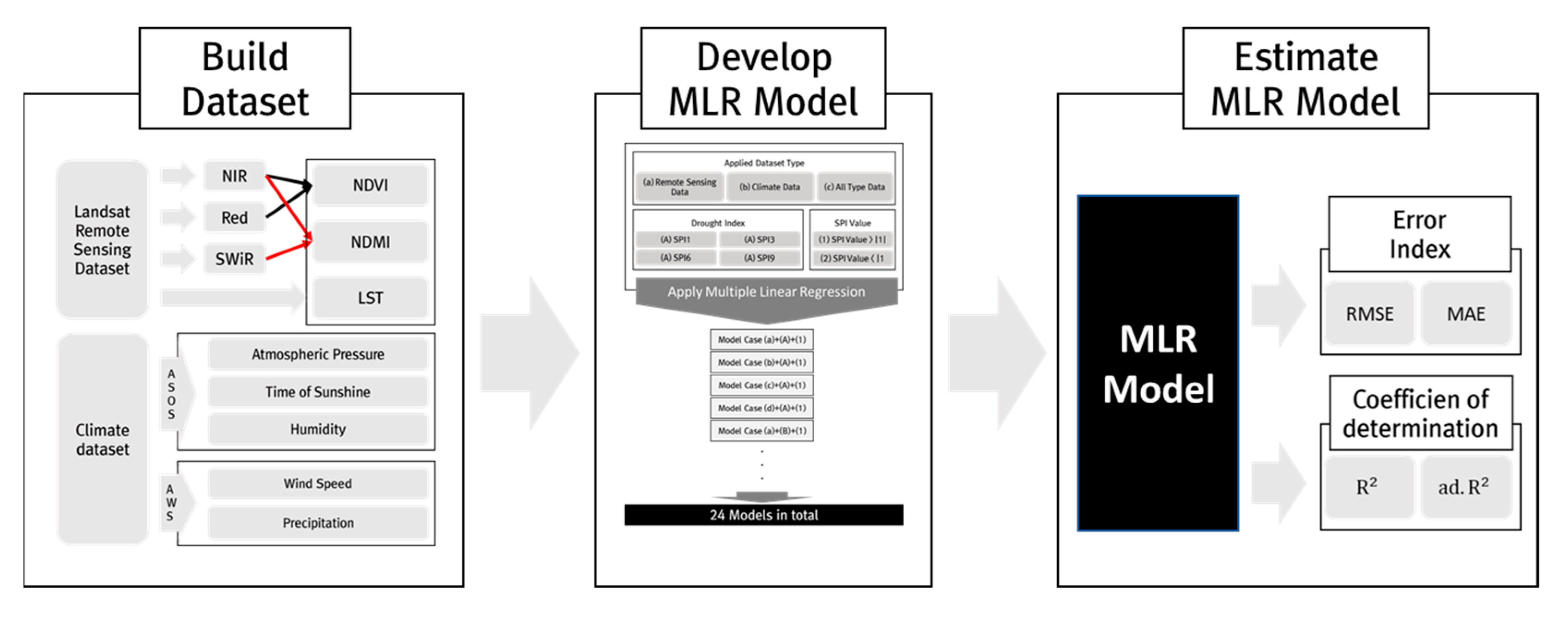
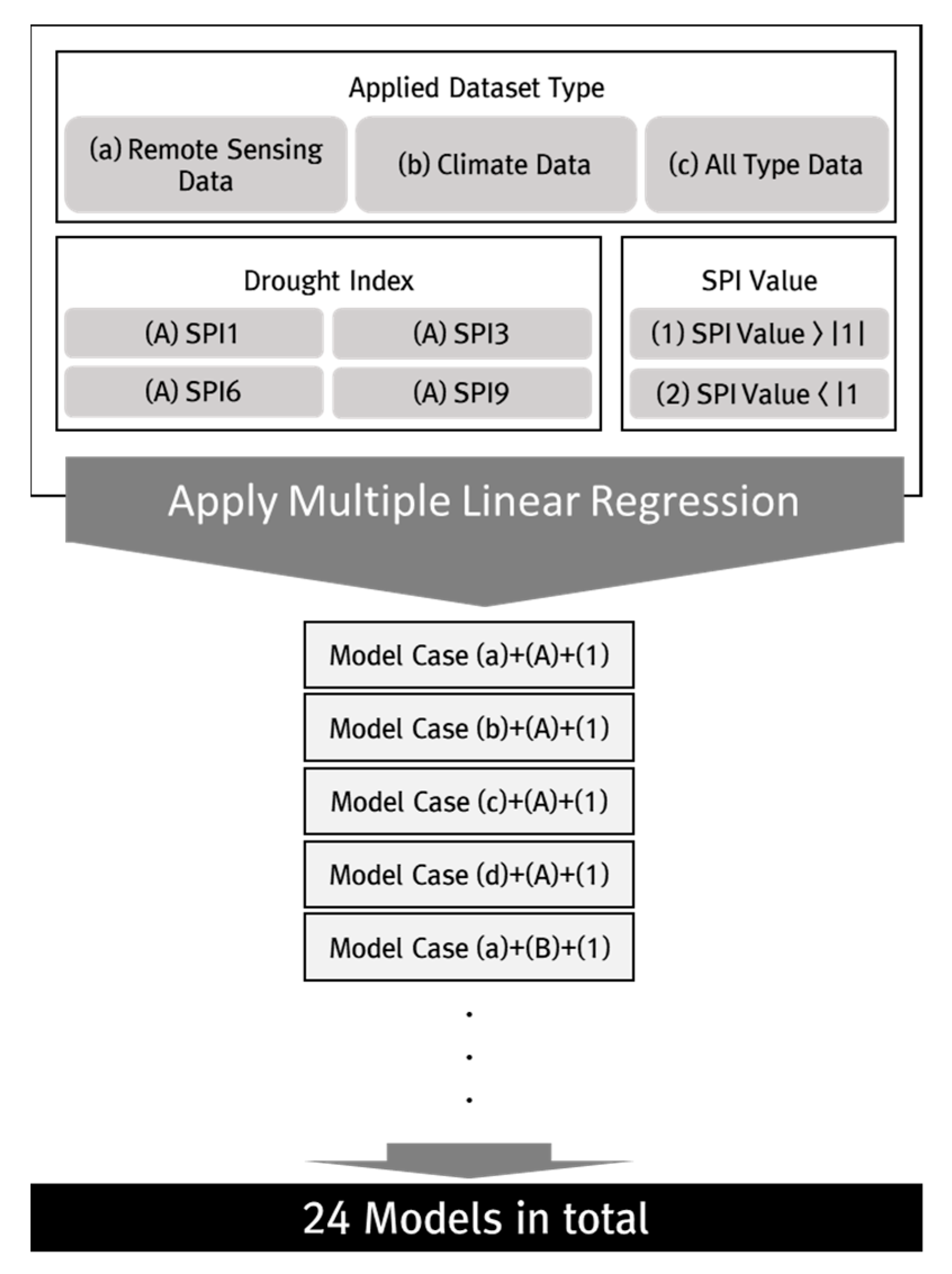
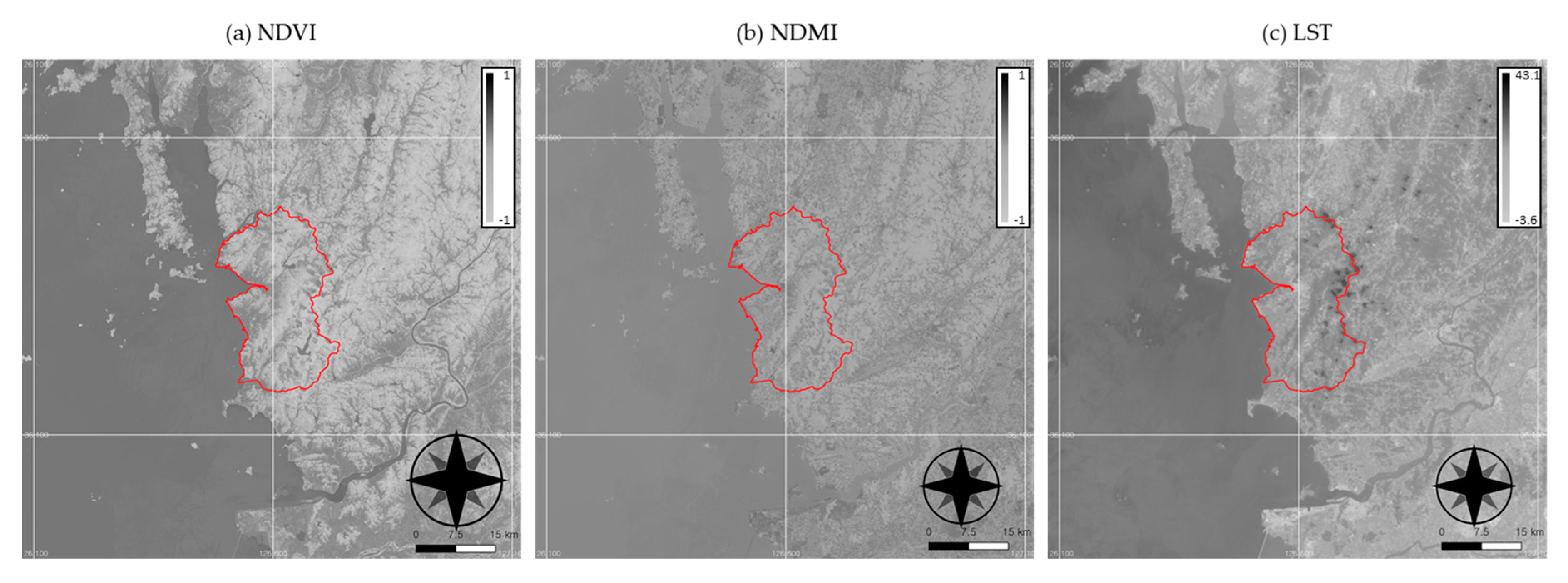
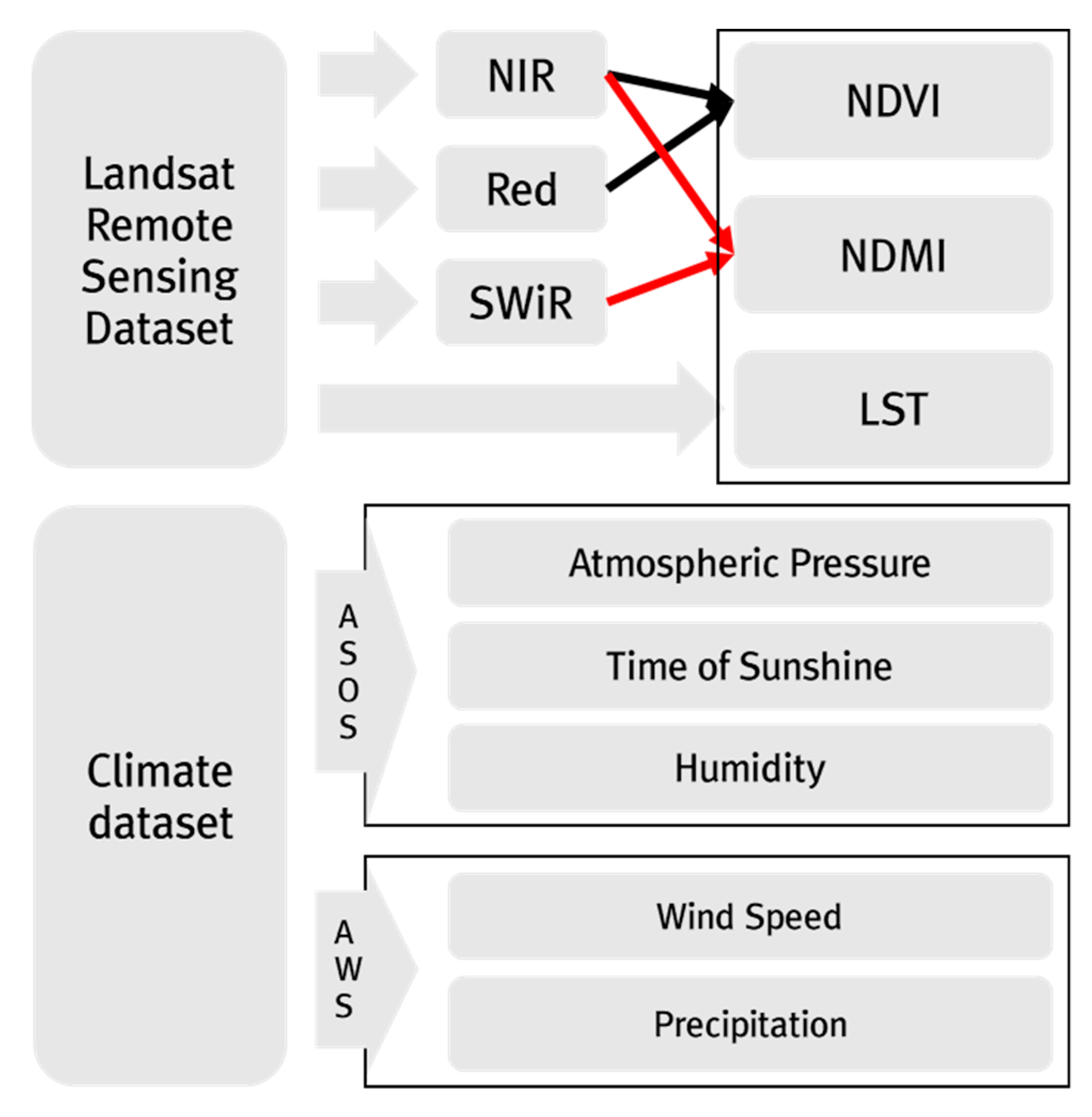
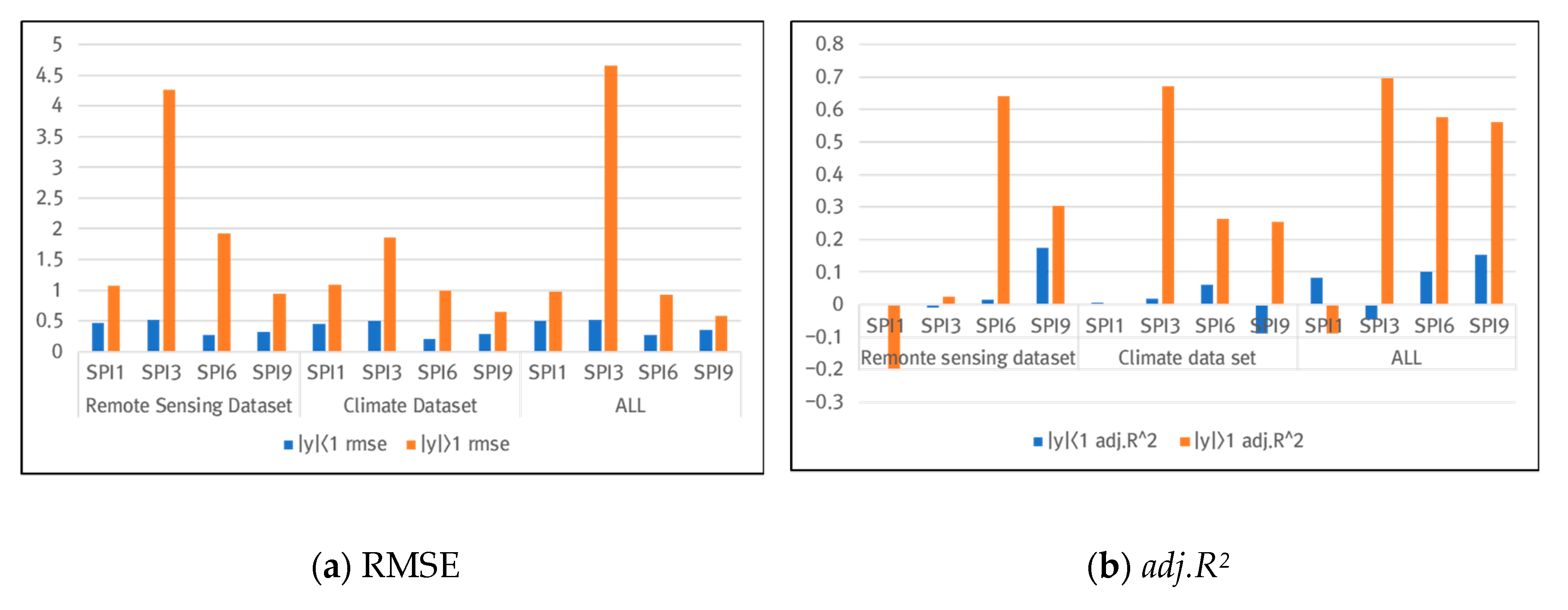
| Data Type | Name | Source |
|---|---|---|
| Drought index | SPI1 | Korea Meteorological Administration |
| SPI3 | ||
| SPI6 | ||
| SPI9 | ||
| Climate data | Atmospheric pressure | |
| Hours of sunshine | ||
| Humidity | ||
| Wind speed | ||
| Precipitation | ||
| Remote sensing data | Landsat 5 | United States Geological Survey |
| Landsat 8 |
| Drought Index | abs(x) < 1 | abs(x) > 1 | Data Used | ||||
|---|---|---|---|---|---|---|---|
| Training (Days) | Testing (Days) | Total (Days) | Training (Days) | Testing (Days) | Total (Days) | ||
| SPI1 | 37 | 10 | 47 (61.8%) | 23 | 6 | 29 (38.2%) | 76 (100%) |
| SPI3 | 44 | 11 | 55 (72.3%) | 17 | 4 | 21 (27.7%) | |
| SPI6 | 41 | 10 | 51 (67.1%) | 20 | 5 | 25 (32.9%) | |
| SPI9 | 39 | 10 | 49 (64.5%) | 21 | 6 | 27 (35.5%) | |
| Spectral | Wavelength | Resolution | Landsat 5 | Landsat 8 |
|---|---|---|---|---|
| Coastal/aerosol | 0.43–0.45 | 30 m | X | Band 1 |
| Band 2—Blue | 0.45–0.51 | 30 m | Band 1 | Band 2 |
| Band 3—Green | 0.53–0.59 | 30 m | Band 2 | Band 3 |
| Band 4—Red | 0.64–0.67 | 30 m | Band 3 | Band 4 |
| Band 5—Near infrared | 0.85–0.88 | 30 m | Band 4 | Band 5 |
| Band 6—Shortwave infrared (1) | 1.57–1.65 | 30 m | Band 5 | Band 6 |
| Band 7—Shortwave infrared (2) | 2.11–2.29 | 30 m | Band 7 | Band 7 |
| Band 8—Panchromatic | 0.5–0.68 | 15 m | X | Band 8 |
| Band 9—Cirrus | 1.36–1.38 | 30 m | X | Band 9 |
| Band 10—Thermal wave infrared (1) | 10.6–11.19 | 30 m | Band 6 | Band 10 |
| Band 11—Thermal wave infrared (2) | 11.5–12.51 | 30 m | Band 11 |
| Band 6 in Landsat 5 | 607.76 | 1260.56 |
| Band 10 in Landsat 8 | 774.89 | 1321.08 |
| Band 11 in Landsat 8 | 480.89 | 1201.14 |
| NDVI Ranges | |
|---|---|
| NDVI < −0.185 | 0.995 |
| −0.185 < NDVI < 0.157 | 0.970 |
| 0.157 < NDVI < 0.727 | 1.0994 + 0.047 ln (NDVI) |
| 0.727 < NDVI | 0.990 |
| Drought Index | < 1 | > 1 | ||||
|---|---|---|---|---|---|---|
| Name | B | t | Name | β | t | |
| SPI1 | 30.93578 | 1.869993 | 3.201459 | 0.040555 | ||
| NDVI | −0.72796 | −0.57769 | NDVI | 10.3628 | 1.290699 | |
| NDMI | −0.53576 | −0.42926 | NDMI | −0.8802 | −0.15897 | |
| LST | −0.02705 | −1.24816 | LST | −0.1316 | −1.13698 | |
| Humidity | 0.001136 | 0.132262 | Humidity | −0.02991 | −0.51526 | |
| Atmospheric pressure | −0.03019 | −1.89291 | Atmospheric pressure | −0.00544 | −0.07237 | |
| Hours of sunshine | 0.012533 | 0.552531 | Hours of sunshine | 0.066898 | 0.586851 | |
| Precipitation | −0.02082 | −1.3711 | Precipitation | 0.830678 | 1.816239 | |
| Wind speed | 0.009283 | 0.258267 | Wind speed | 1.160823 | 2.029992 | |
| SPI3 | 12.90911 | 0.836061 | 188.1064 | 0.896862 | ||
| NDVI | 0.950619 | 0.641093 | NDVI | 11.73426 | 1.403033 | |
| NDMI | −0.71064 | −0.4874 | NDMI | −9.47014 | −1.83521 | |
| LST | −0.01654 | −0.81279 | LST | −0.2059 | −1.37255 | |
| Humidity | 0.002449 | 0.299923 | Humidity | −0.04421 | −0.36255 | |
| Atmospheric pressure | −0.01319 | −0.88639 | Atmospheric pressure | −0.18753 | −0.94184 | |
| Hours of sunshine | 0.029607 | 1.413231 | Hours of sunshine | 0.300978 | 3.479056 | |
| Precipitation | 0.008584 | 0.56126 | Precipitation | 1.400166 | 2.694312 | |
| Wind speed | −0.01367 | −0.4086 | Wind speed | −0.12401 | −0.13981 | |
| SPI6 | −17.8702 | −0.94269 | −22.093 | −0.3271 | ||
| NDVI | 1.885811 | 1.142978 | NDVI | 1.210822 | 0.362712 | |
| NDMI | −1.66831 | −1.25147 | NDMI | −16.4954 | −2.84382 | |
| LST | −0.05058 | −2.05796 | LST | 0.206092 | 2.408501 | |
| Humidity | 0.010077 | 1.062627 | Humidity | −0.02773 | −0.9022 | |
| Atmospheric pressure | 0.01683 | 0.923181 | Atmospheric pressure | 0.022646 | 0.348437 | |
| Hours of sunshine | 0.029999 | 1.324477 | Hours of sunshine | 0.060488 | 0.867988 | |
| Precipitation | −0.01364 | −0.79141 | Precipitation | 0.041249 | 0.197038 | |
| Wind speed | 0.079958 | 1.983995 | Wind speed | 0.043233 | 0.174417 | |
| SPI9 | 20.35591 | 1.187025 | 150.916 | 2.859393 | ||
| NDVI | −2.10529 | −1.19325 | NDVI | 10.67731 | 3.764342 | |
| NDMI | 2.755888 | 2.25374 | NDMI | −9.92022 | −2.10782 | |
| LST | −0.0162 | −0.63835 | LST | −0.17683 | −2.56174 | |
| Humidity | −0.01264 | −1.39552 | Humidity | −0.01482 | −0.60831 | |
| Atmospheric pressure | −0.01872 | −1.13645 | Atmospheric pressure | −0.14861 | −2.88596 | |
| Hours of sunshine | −0.01061 | −0.53462 | Hours of sunshine | −0.00033 | −0.0061 | |
| Precipitation | 0.00695 | 0.453522 | Precipitation | 0.159975 | 1.010333 | |
| Wind speed | −0.06159 | −0.9094 | Wind speed | 0.213445 | 2.516916 | |
| MLR Model Type | < 1 | > 1 | |||||
|---|---|---|---|---|---|---|---|
| R2 | adj.R2 | F | R2 | adj.R2 | F | ||
| Remote sensing dataset | SPI1 | 0.083 | −0.001 | 0.993 | 0.042 | −0.198 | 0.175 |
| SPI3 | 0.060 | −0.010 | 0.853 | 0.318 | 0.025 | 1.086 | |
| SPI6 | 0.090 | 0.016 | 1.219 | 0.699 | 0.642 | 12.360 | |
| SPI9 | 0.240 | 0.175 | 3.687 | 0.403 | 0.303 | 4.048 | |
| Climate dataset | SPI1 | 0.143 | 0.005 | 1.038 | 0.336 | 0.003 | 1.010 |
| SPI3 | 0.132 | 0.018 | 1.157 | 0.836 | 0.673 | 5.111 | |
| SPI6 | 0.179 | 0.062 | 1.528 | 0.458 | 0.265 | 2.369 | |
| SPI9 | 0.054 | −0.089 | 0.378 | 0.432 | 0.254 | 2.434 | |
| ALL | SPI1 | 0.286 | 0.082 | 1.038 | 0.491 | −0.090 | 0.993 |
| SPI3 | 0.149 | −0.046 | 1.157 | 0.939 | 0.696 | 3.857 | |
| SPI6 | 0.282 | 0.102 | 1.528 | 0.755 | 0.577 | 2.369 | |
| SPI9 | 0.332 | 0.154 | 0.378 | 0.729 | 0.562 | 4.366 | |
| Dataset Type | Drought Index | < 1 | > 1 | ||
|---|---|---|---|---|---|
| RMSE | MAE | RMSE | MAE | ||
| Remote sensing dataset | SPI1 | 0.461063 | 0.370168 | 1.072839 | 0.849006 |
| SPI3 | 0.523966 | 0.416656 | 4.267451 | 4.104682 | |
| SPI6 | 0.27108 | 0.188283 | 1.923501 | 1.811254 | |
| SPI9 | 0.32929 | 0.277475 | 0.94953 | 0.783517 | |
| Climate dataset | SPI1 | 0.452923 | 0.37194 | 1.088043 | 1.075702 |
| SPI3 | 0.497007 | 0.416431 | 1.862151 | 1.633461 | |
| SPI6 | 0.203024 | 0.155876 | 0.992578 | 0.972057 | |
| SPI9 | 0.288397 | 0.208415 | 0.656523 | 0.51566 | |
| All | SPI1 | 0.496679 | 0.366467 | 0.98449 | 0.829243 |
| SPI3 | 0.512742 | 0.420862 | 4.649667 | 4.220784 | |
| SPI6 | 0.278393 | 0.157571 | 0.928345 | 0.907182 | |
| SPI9 | 0.352182 | 0.290329 | 0.580824 | 0.4903 | |
| < 1 | > 1 | ||||||
|---|---|---|---|---|---|---|---|
| B | adj.R2 | RMSE | β | adj.R2 | RMSE | ||
| SPI1 | 12.8573 | 0.005307 | 0.452923 | 12.8573 | 0.003338 | 1.088043 | |
| Humidity | 0.001261 | 0.001261 | |||||
| Atmospheric pressure | −0.01282 | −0.01282 | |||||
| Hours of sunshine | 0.021296 | 0.021296 | |||||
| Precipitation | −0.03012 | −0.03012 | |||||
| Wind speed | −0.01179 | −0.01179 | |||||
| SPI3 | 13.44063 | 0.017954 | 0.497007 | 188.1064 | 0.695654 | 4.649667 | |
| NDVI | (N/V) | 11.73426 | |||||
| NDMI | (N/V) | −9.47014 | |||||
| LST | (N/V) | −0.2059 | |||||
| Humidity | 0.000101 | −0.04421 | |||||
| Atmospheric pressure | −0.01355 | −0.18753 | |||||
| Hours of sunshine | 0.032714 | 0.300978 | |||||
| Precipitation | 0.006508 | 1.400166 | |||||
| Wind speed | −0.03087 | −0.12401 | |||||
| SPI6 | −20.8531 | 0.061902 | 0.203024 | −0.16286 | 0.64204 | 1.923501 | |
| NDVI | (N/V) | 2.309607 | |||||
| NDMI | (N/V) | −17.988 | |||||
| LST | (N/V) | 0.160818 | |||||
| Humidity | 0.003844 | (N/V) | |||||
| Atmospheric pressure | 0.02011 | (N/V) | |||||
| Hours of sunshine | 0.034192 | (N/V) | |||||
| Precipitation | −0.02157 | (N/V) | |||||
| Wind speed | 0.027265 | (N/V) | |||||
| SPI9 | 8.405069 | −0.08918 | 0.288397 | 150.916 | 0.561834 | 0.580824 | |
| NDVI | (N/V) | 10.67731 | |||||
| NDMI | (N/V) | −9.92022 | |||||
| LST | (N/V) | −0.17683 | |||||
| Humidity | −0.0089 | −0.01482 | |||||
| Atmospheric pressure | −0.00744 | −0.14861 | |||||
| Hours of sunshine | −0.01545 | −0.00033 | |||||
| Precipitation | 0.004597 | 0.159975 | |||||
| Wind speed | −0.03652 | 0.213445 | |||||
Publisher’s Note: MDPI stays neutral with regard to jurisdictional claims in published maps and institutional affiliations. |
© 2020 by the authors. Licensee MDPI, Basel, Switzerland. This article is an open access article distributed under the terms and conditions of the Creative Commons Attribution (CC BY) license (http://creativecommons.org/licenses/by/4.0/).
Share and Cite
Kim, S.W.; Jung, D.; Choung, Y.-J. Development of a Multiple Linear Regression Model for Meteorological Drought Index Estimation Based on Landsat Satellite Imagery. Water 2020, 12, 3393. https://doi.org/10.3390/w12123393
Kim SW, Jung D, Choung Y-J. Development of a Multiple Linear Regression Model for Meteorological Drought Index Estimation Based on Landsat Satellite Imagery. Water. 2020; 12(12):3393. https://doi.org/10.3390/w12123393
Chicago/Turabian StyleKim, Seon Woo, Donghwi Jung, and Yun-Jae Choung. 2020. "Development of a Multiple Linear Regression Model for Meteorological Drought Index Estimation Based on Landsat Satellite Imagery" Water 12, no. 12: 3393. https://doi.org/10.3390/w12123393
APA StyleKim, S. W., Jung, D., & Choung, Y.-J. (2020). Development of a Multiple Linear Regression Model for Meteorological Drought Index Estimation Based on Landsat Satellite Imagery. Water, 12(12), 3393. https://doi.org/10.3390/w12123393






